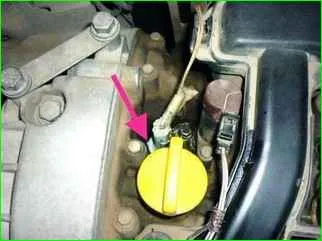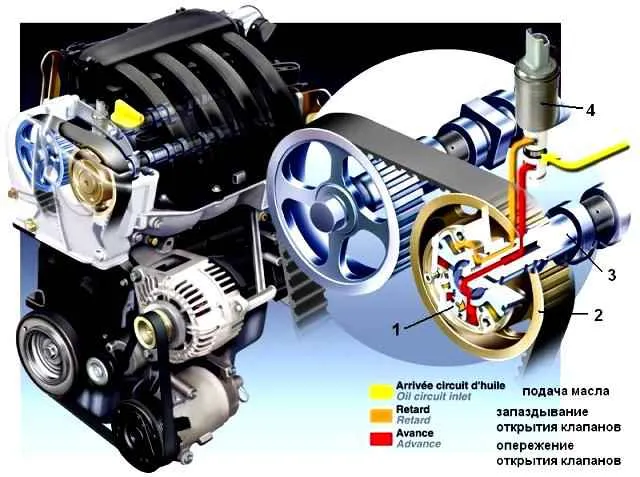To improve the filling of the cylinders with fuel mixture in all modes, 1.6 l engines. equipped with a phase regulator of the intake valve camshaft
Shifting the closing moment of the intake valves optimizes the filling of the cylinders with a fuel mixture depending on the crankshaft speed.
As a result, the torque at medium loads and power at high crankshaft speeds increase.

At high crankshaft speeds, later closing of the intake valves ensures the supply of an additional portion of the fuel mixture for due to the high speed of the mixture movement.
On the contrary, at low rotation speeds, the inertia of the mixture movement is small.
Therefore, it is desirable to close the exhaust valves earlier in order to avoid insufficient filling of the cylinders and loss of torque due to the displacement of part of the fresh mixture.
The higher the crankshaft speed, the later the intake valves should close.

The amount of oil supplied to the phase regulator is determined by the electromagnetic valve mounted on the cylinder head (see Fig. 2).
The valve is supplied with power in the form of an alternating signal of the degree of cyclic opening (amplitude of 12 V and frequency of 250 Hz).
This allows oil to be supplied to the phase regulator mechanism and thus change the phase shift angle.

The camshaft phase regulator constantly changes the valve timing.
The ECU sends a variable signal of the degree of cyclic opening to the electromagnetic valve, the value of which is proportional to the required phase shift.
The phases constantly change from 0˚ to 43˚ according to the angle of rotation of the crankshaft.
When the crankshaft speed is within 1500–4300 min –1, the ECU supplies supply voltage to the electromagnetic valve.
When 4300 min –1 is exceeded, the power supply to the electromagnetic valve is cut off.
In this case, the position of the phase regulator mechanism promotes filling of the cylinders at high crankshaft speed. In this position, the locking plunger locks the mechanism.
At a speed of up to 1500 min-1 –1, the supply voltage is not supplied to the electromagnetic valve.
The mechanism is locked by the plunger.
From the moment power is supplied to the electromagnetic valve at a crankshaft speed of more than 1500 min-1 –1, under the action of oil pressure, the locking plunger moves away and releases the mechanism.
The electromagnetic valve of the camshaft phase regulator is controlled under the following conditions:
- - the crankshaft speed sensor is in good condition;
- - the camshaft position sensors are in good condition;
- - the injection system is in good condition;
- - after starting the engine;
- - the engine does not run at idle with the accelerator pedal pressed;
- - the injection profile threshold value has been obtained, which is set taking into account the load and crankshaft speed;
- - the coolant temperature is within 10 — 120˚ C;
- - increased engine oil temperature.
Standby modes:
- - return of the phase regulator to its original position;
- - zero phase shift.
Note. When the electromagnetic valve is locked in the open position, the engine does not operate stably at idle, the pressure in the intake pipe is increased. In this case, the engine runs noisier.
The main faults of the electromagnetic valve of the phase regulator:
- - open circuit;
- - short circuit to ground or to +12V;
- - shift or discrepancy of programmed values;
- - incorrect determination of the position of the phase regulator;
- - the regulation value is outside the permissible limits.





